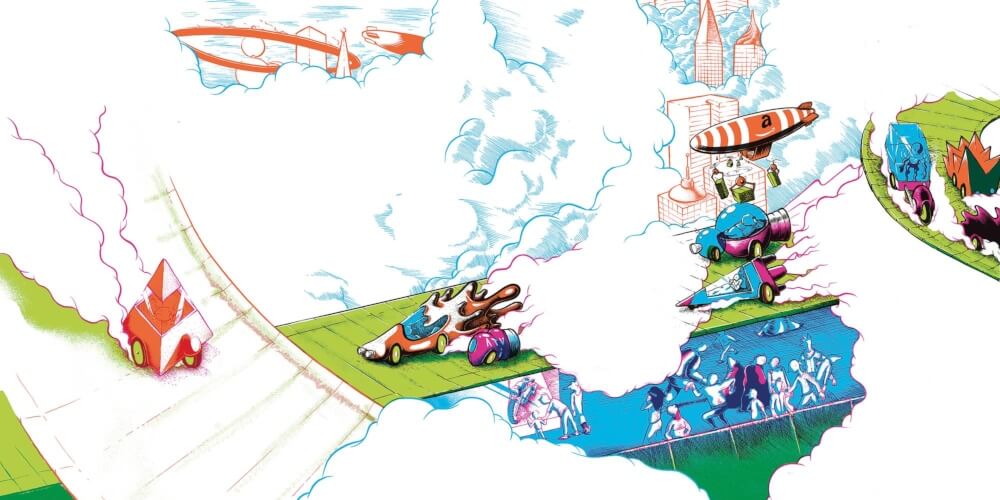
In 2018, self-driving automobiles are likely to morph from carefully-monitored prototypes into deliverable products, doing real work. We showed in the August 2017 issue of Trends, that at least a dozen companies will have Level 4 or 5 autonomous automobiles on the road by 2025.
The Society of Automotive Engineers (or SAE) defines a Level-5 vehicles as one that can operate without a driver almost anywhere, and in almost all road and weather conditions. A level 4 vehicle differs from a Level 5 vehicle, in that it can only operate autonomously in certain areas that have been fully mapped and under normal road conditions.
The key take-away is that that, starting as early as next year, driverless cars will be in commercial service with ridesharing services such as Uber and Lyft. And, while it will start with this limited application in places like Singapore and San Francisco, it will quickly grow into a global reality by 2025.
Experts estimate that Level-4 self-driving technology will initially add about $10,000 to the price of a vehicle. The Trends editors believe that for EU and North American markets, this price is at or near "the price corridor of the mass" made famous in the book, Blue Ocean Strategy. Better yet, that premium is likely to diminish quickly, under the convergent forces of economies of scale, learning curve effects, Moore's law, and competitive pressures.
As a result, the market will readily absorb as many as 10 million self-driving vehicles in the coming decade and by 2037, they will be the norm on highways throughout the OECD.
Given this trend we offer the following forecasts for your consideration. First, the distinctive characteristics of self-driving automobiles will inevitably favor the "mobility as a service" (or MAAS) business model.
The popularity of Uber and Lyft demonstrates that consumers like to have affordable transportation on call, without the upfront costs, on-going maintenance, and parking hassles of owning a car. Arguably, a sizeable fraction of the population will still want to own traditional and self-driving cars for multiple reasons. However, once the cost of the driver is taken out of the Uber ride-hailing equation, it will be impossible for the life-cycle cost of car ownership to compete with MAAS for most "use cases." Under this model, fleets of autonomous cars will roam cities waiting for passenger calls 24/7, selecting passengers based on various optimization algorithms. The result will be extremely high utilization rates and consequently far fewer total vehicles in service.
Second, because of ultra-high utilization rates, self-driving cars will have short useful lives. Futurist Thomas Frey estimates that the life expectancy of autonomous vehicles will be less than 1 year rather that than the 11.5 years which cars are averaging today. "Within ten years as speeds increase and cars begin to average 60-to-70 mph on open freeways, a single car could easily average 1,000 miles a day.
Over a 10-month period, a single car could travel as much as 300,000 miles. Cars today are only in use 4% of the day, or less than an hour a day. An electric autonomous vehicle could be on-the-road as much as 20 hours a day, which is 21 times as much as the average car today. For vehicles operating on a 24/7 timetable, that still leaves plenty of time for recharging, cleaning, and maintenance."
Third, under the MAAS model, one autonomous car will replace about 30 traditional cars. According to Frey, 2028-to-2030 will be the years of peak messiness for the driverless car revolution. There are roughly 258 million registered cars in the U.S. and replacing them will be a long drawn out process. Frey estimates for a city of 2 million people, a fleet of 30,000 autonomous vehicles will displace 50% of peak commuter traffic.
During off-peak times, 30,000 autonomous vehicles will handle virtually all other transportation needs. And, less than 4 million autonomous cars will replace 50% of all commuter traffic in the U.S., or roughly 129 million vehicles. Given current projections of 17-to-18 million new vehicles sold annually in the U.S., a fleet of even 1 million autonomous vehicles will make a serious dent in traditional car sales.
Fourth, fleet owners will become the primary influencers on the design of new cars. The thinking of large fleet owners will dominate the autonomous car market. Their focus will be on vehicle costs, repair records, maintenance, cleaning expenses, and operational efficiencies. In a competitive consumer marketplace they will also have to pay close attention to comfort, convenience, and the overall user experience. AI-driven fleet management systems will be tasked with ensuring cars are in the right place at the right time to meet user demand. It will take years of operational experience to make this type of fleet management software work efficiently.
Fifth, over 50% of driverless cars will be one-passenger vehicles. Since 76% of cars on the road only have one person in them, and since one-person vehicles will be cheaper, most autonomous fleets will be designed around single-passenger occupancy.
Sixth, Mobility as a Service, will jeopardize 40% of today's sales tax revenue. Today, roughly 40% of state and local sales tax comes from consumer auto sales. Under the current rules, all cars in a commercial fleet are exempt from sales tax. Expect cities and states to create new taxes to replace these lost revenues.
Seventh, most retail businesses associated with cars will disappear. Over 10% of today's retail businesses are connected with cars. As personal ownership of cars begins to shrink, we will see a rapid decline in gas stations, car washes, oil change businesses, detail shops, tire shops, brake shops, emissions testing, alignment shops, auto repair, body shops, tow trucks, glass repair, transmission repair, auto parts stores, rental car agencies, and auto insurance offices. Dealerships themselves will also disappear.
Eighth, in the world of self-driving and Mobility as a Service, police departments will shrink. In most U.S. cities, 80% of police departments are dedicated to traffic control. Without DUI fines, speeding tickets, and parking fees, most police departments will be trimmed to a bare minimum. New York City could lose over $2 billion per year in traffic fines. According to Frey the "Big Apple" collected a whopping $1.9 billion from traffic violations in 2015, and this number has been steadily increasing over time.
Ninth, airports will lose one-third to one-half of their revenues as reliance on MAAS grows. According to the Airports Council International-North America, 41% of airport revenue in the U.S. comes from parking and ground transportation services. Virtually all of this will disappear over the coming years.
Tenth, Automobile related health care cost could decline by $500 billion per year. The National Safety Council estimates 38,300 people were killed and 4.4 million injured on U.S. roads in 2015. Driverless cars have the potential to push those numbers nearly to zero. If we consider how low the accident/injury rate is for the airline industry, that's roughly what we should expect with 100% autonomous vehicles. If we multiply the average cost of repairing a person after a traffic injury, say $10,000, times the number of injuries, 4.4 million, we end up with a potential drop of $440 billion in payments to hospitals and the healthcare industry.
For 2015, the CDC estimates that the 38,300 Americans killed resulted in $62 billion in medical and work-loss costs in addition to the immeasurable burden on the victims' families and friends. That's over half a trillion dollars a year, in the U.S. alone, that simply goes away. How much of that we would save with a 50-50 mix of traditional and automated cars on the road at any one time, is unclear.
Eleventh, remodeling garages in people's homes will become a thriving industry in the 2020s. Due to car ownership declines, garages will be less needed as a place to park cars. As an AirBNB rental, a nicely remodeled garage, set up as a separate living unit, could add $1,500-to-$2,000 a month in rent payments, to the average homeowner's income.
Twelfth, in the United States alone as much as 5 million acres of parking space will become available for redevelopment over the next 20 years.
Demand for parking will begin to dwindle over the coming decades and the excess property will be sold as prime real estate for redevelopment. The United States has an amazing amount of land dedicated to parking; e. g., 14% of Los Angeles is currently used for parking.
Thirteenth, overall ground transportation costs will shrink by 50%. According to a 2015 AAA study, the average person spends $8,698 a year on their car and drives an average of 15,000 miles per year. That works out to $725 a month. For autonomous vehicles, projected annual spending on transportation will be $0.28/mile * 15,000 miles or $350/month. Better still, the 28 cents per mile used in this calculation should drop as fleet owners develop more efficient systems
Fourteenth, driverless technologies will cause 25% of today's jobs to disappear by 2040. Virtually every aspect of society, in every country around the world, will be touched by driverless technologies, and the vast majority of it is destined to improve our global standard of living. The Trends editors are confident that job losses will be offset by job creation. Businesses that disappear will be replaced by innovative new businesses built around the ingenious new capabilities autonomous vehicles provide.
Fifteenth, the driverless future will not lead to a one-size-fits-all solution. Just as wealthy people today enjoy the status of driving a more expensive car, not all driverless vehicles will serve the same utilitarian function. Richer people will pay to "arrive in style," and will expect to have premier access to buildings. In much the same way hotels often greet their elite guests with teams of people waiting on their arrival, retail stores will find ways to greet their most prominent customers and make them feel welcome.

